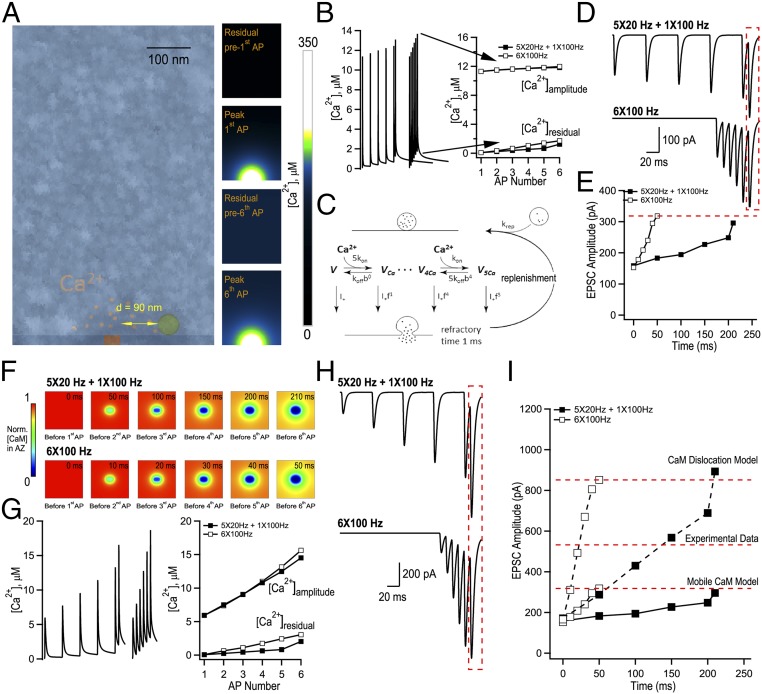Fig. 4.
Modeling of evoked presynaptic Ca2+ dynamics and vesicular release reveals a plausible mechanism for AP counting logic in MFB terminals. (A, Left) Geometry of a parallelepiped-shaped modeling unit (0.5 µm × 0.5 µm × 0.79 µm) used in VCell simulations representing part of an MFB containing a single AZ with a 40 nm × 80 nm VGCC cluster, overlaid with a representative electron microscopy image that depicts part of an MFB with a single AZ (see Materials and Methods for details). (A, Right) Snapshots of VCell-computed spatial [Ca2+] profiles in the central XZ modeling unit plane during 6 × 100-Hz AP stimulation in the limiting case of Mobile CaM model. (B, Left) VCell-computed [Ca2+] transients at the release site located at 90 nm away from the VGCC cluster during 6 × 100 Hz and 5 × 20 + 1 × 100-Hz AP trains. (B, Right) Plot of corresponding residual [Ca2+]residual and amplitude [Ca2+]amp = [Ca2+]peak − [Ca2+]residual respectively, before and after each AP in the trains. (C) Schematics of the modified allosteric model of Ca2+-driven vesicle release and replenishment (20). (D) Simulated EPSCs, average of M = 60,000 Monte Carlo runs for each paradigm scaled for RRP of size m = 125. (E) Summary graph showing simulated EPSC amplitude as a function of time for the two stimulation paradigms shown in D. (F) Snapshots of spatial distribution of normalized total [CaM] (which accounts for all CaM molecules irrespective of their Ca2+ binding state) in the AZ plane, illustrating progressive dislocation of CaM from the membrane during AP stimulation predicted by CaM dislocation model (21) (see Materials and Methods for details). (G) VCell-computed [Ca2+] transients at the release site during 6 × 100 Hz and 5 × 20 Hz + 1 × 100 Hz AP trains and (H) corresponding simulated EPSCs for the case of CaM dislocation model. (I) Summary graph showing that experimentally observed short-term facilitation levels are likely to be explained by joint contribution of the two limiting cases represented by Mobile CaM (low facilitation) and by CaM dislocation (high facilitation) models that both allow AP counting logic.

